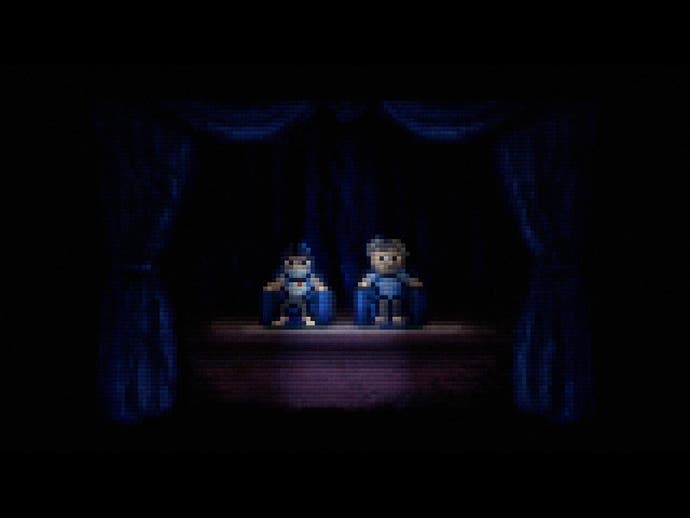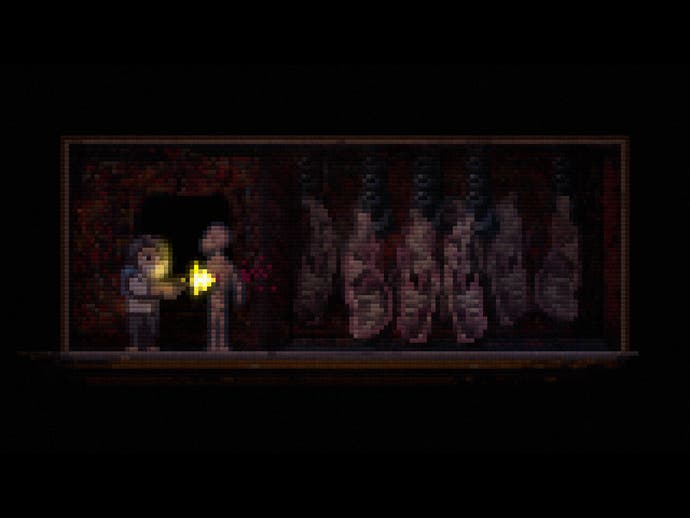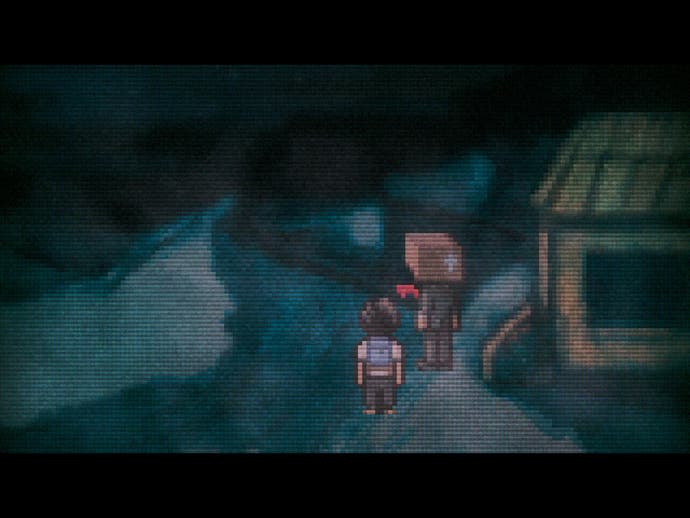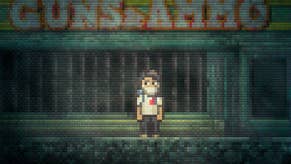Lone Survivor Review
You can tell from the pixels.
There's a section in Lone Survivor where you find yourself in an old arcade, shrouded in darkness, a series of cabinets against the wall. As you pass each one, your character comments on the game on-screen. It's a game about guilt," he says. "It's about a boy and a girl." "It looks kinda retro." "It's just another zombie game."
Really, he's talking to us, not himself. And he's talking about the game we're playing rather than the ones he's looking at. Lone Survivor is extremely self-aware, revelling in its own sense of mystery. But where such fourth-wall-breaking might leave lesser games feeling pretentious, Lone Survivor weaves it into its darkly fascinating, open-ended plot.
It's a survival horror game of sorts, and about as indie as they come. Played in a fixed resolution of 160x90, although scaled up to fill the screen, it's drenched in muddy, pixelated atmosphere. It operates on a side-scrolling pane, each room or corridor a different screen, and you'll spend most of your time moving left or right and pressing X to interact.
But behind this stripped-down facade lies something deeply complex. It's a game that refuses to lead you by the hand, instead dropping cryptic hints into your path as you strive to work out its systems. Success in Lone Survivor means experimentation in the face of danger: an apparent zombie apocalypse, characters you can't trust, and only a single save slot.

It takes place over a series of days (how many depends on how you choose to play) beginning in the apartment you call home. It's not yours, but the game never reveals whose it is. What happened to unleash what seems to be a viral outbreak that's turned the city into monsters? You don't know. Other people seem like they might, but no one's sharing.
Lone Survivor wastes no time in being relentlessly weird. From the outset, your nameless character hallucinates, crawls through holes that lead to otherworldly scenes, and repeatedly questions his own sanity. You soon discover that mirrors act as portals that warp you between your apartment and other parts of the game world - they function as an intriguing save system that forces you to think carefully about when to retire to your bed for the night.
It's a game, primarily, about surviving this strange reality. As the game's clock ticks onwards, you become hungry and tired, and it's up to you to manage the apparently meagre resources that dot the rooms and halls of your large apartment complex. Grow too hungry and you'll starve to death. Become exhausted and your screen begins to waver and distort. I never did find the courage to see what happens if you don't get enough rest.
Nothing's ever easy, but it's to the game's enormous credit that it provides so many options. You can just about get by on snacks alone, but find a gas canister and a pan and you'll be able to cook a proper meal. Tinned food is plentiful, but there's only one can opener in the whole game, and it's astonishingly well hidden. You're introduced to three different pills, which mysteriously appear in your bathroom every night. What does each one do? The game never tells you outright, so it's up to you to explore their effects - both positive and negative.
Don't expect a moment where it all clicks into place, either. From start to finish, Lone Survivor delights in challenging your expectations, asking questions of both you and your character. There are inventory puzzles, most of which involve slightly tedious hunts for items scattered around the world, but the biggest challenges you'll face are in your understanding of the game's multi-layered mechanics and how they all fit together.

There's combat, and while it's largely optional, it would take an extremely patient player to get through the game without firing a weapon. It's one of the game's weaker areas: switching into combat mode fixes your view in a single direction, which makes navigation troublesome in the heat of battle. The selection of enemies you'll encounter is small, but each one is impressively grotesque, and their abilities shift over time, meaning you're never quite sure what you'll be up against.
But there are ways of distracting the enemies, too, which allows you to sneak past using convenient nooks in walls as hiding spots. Doing so means you'll save on resources, but with frequent repeat visits to many areas, it also means going through the motions each new time you require access. The choice is entirely yours, though, and the game is careful never to punish you for making that call. In fact, quite the opposite is true: the story can pan out in one of several ways, and your choice of play style determines the ending you'll get.
Then there are the dreams: baffling, impenetrable scenes in which you find yourself on a theatre stage with a person who insists you've met before, or where men with boxes on their heads speak to you in riddles. They add new interpretations to the fiction, but they also serve a functional purpose. Once again, that purpose is yours to figure out.
Lone Survivor was made primarily by a single developer, Jasper Byrne, and that shows. Some wonderful stylistic touches remain consistent throughout and the game has a crystal clear vision that's obvious from the outset. In other ways, the one-man show is more problematic. Occasionally, it feels as though the designer was a little too close to his own work, with essential secrets that are slightly too well-hidden, or an assumption that you'll be willing to take risks where the game has given you no indication that it's the sensible thing to do.

We're accustomed to survival horror games where the most effective way to play is to err on the side of caution. Lone Survivor isn't like that: it keeps you on your toes throughout, but the way it responds to your choices means you'll rarely back yourself into an irreparable situation. Ultimately, the decision to allow you only one save slot is revealed to be a smart one, but I wish the game had been more clear about this from the start.
The saving system, incidentally, is one I'm still not sure about. It's often frustrating to have to put your objective on hold, find a mirror and warp back to your apartment. At the same time, though, this feeling of frustration is a core part of how Lone Survivor's tension works: it is, after all, a game about staying alive rather than racing forward.
There is such a clear understanding of how to generate real fear. Lone Survivor never once made me jump, nor did it especially disturb me, but I can't think of another game that's made my heart race quite so much upon opening a door. It achieves this primarily through some incredible sound design - scratchy, muffled and horrifically alien - but also through immaculate pacing, abject confusion, and some tremendous artistry crammed into the few pixels it possesses.
It's true that Lone Survivor owes a lot to the atmosphere of early Silent Hill, and there are a few thematic nods to David Lynch's '90s weirdo drama, Twin Peaks. But beneath them lies an intricate and unique game that takes the best of old-style survival horror and warps it into something all of its own. It's brave, uncompromising, and a little bit knowing - and, crucially, it's got more than enough substance to back up its style.












